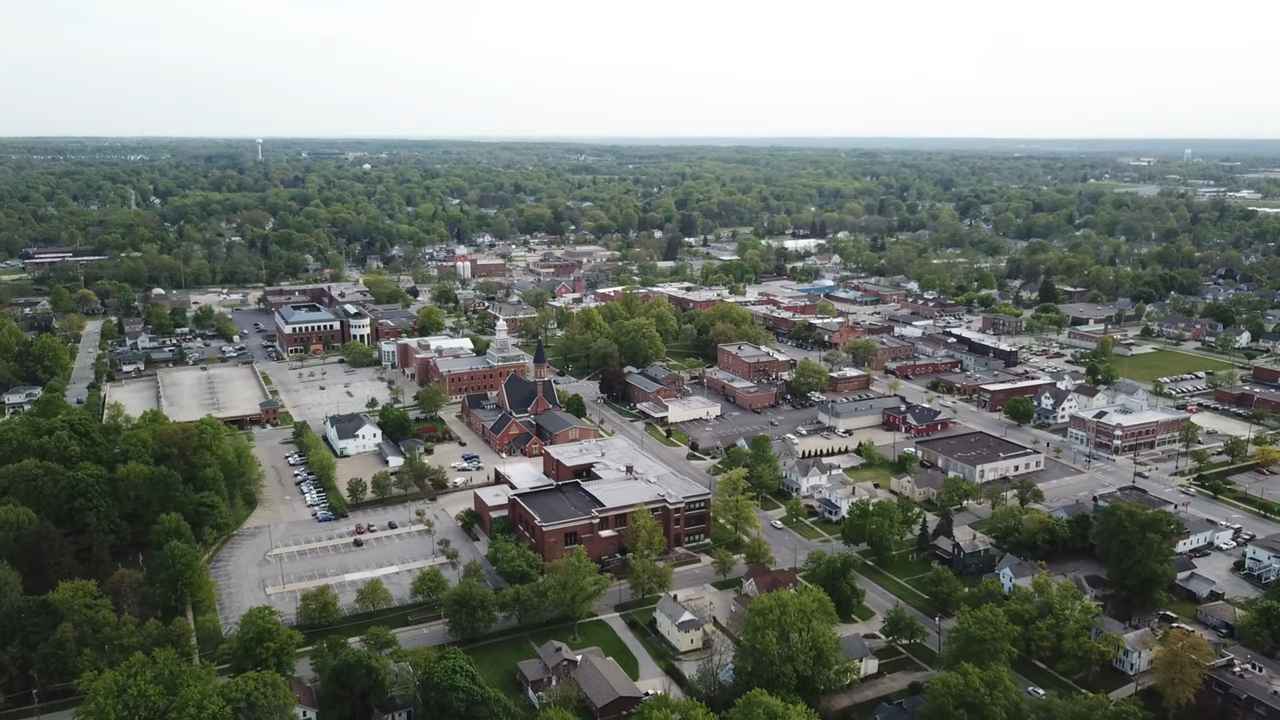Learning about the wealthiest counties in Ohio reveals more than just numbers. It reflects:
- Economic health
- Development priorities
- Regional prosperity
By focusing on median household income, a clearer picture of typical financial strength emerges.
That is why we would like to talk about the richest counties you will find in Ohio in 2025.
The following rankings reflect the most recent and reliable data available.
| # | County | Median Household Income | Home Value | Unemployment Rate |
|---|---|---|---|---|
| 10 | Licking County | $81,033 | $232,200 | 3.3% |
| 9 | Putnam County | $82,785 | $176,200 | 2.2% |
| 8 | Clermont County | $83,178 | $224,800 | 4.1% |
| 7 | Greene County | $85,218 | $222,300 | 4.5% |
| 6 | Fairfield County | $87,069 | $247,800 | 3.6% |
| 5 | Medina County | $92,660 | $249,700 | 3.0% |
| 4 | Geauga County | $100,783 | $288,000 | 3.1% |
| 3 | Warren County | $107,843 | $290,900 | 3.0% |
| 2 | Union County | $109,506 | $282,900 | 2.9% |
| 1 | Delaware County | $130,088 | $393,000 | 3.0% |
10. Licking County

- Median Household Income: $81,033
- Home Value: $232,200
- Unemployment Rate: 3.3%
Licking County’s economic profile shifted dramatically following Intel’s announcement of a new semiconductor manufacturing facility.
That investment brought national attention and spurred a wave of housing development, job growth, and infrastructure planning.
Newark, the largest city, is experiencing revitalization across commercial districts and residential neighborhoods. Construction, engineering, and service jobs are rising rapidly.
County officials are collaborating with educational institutions to prepare the workforce for future tech industry demands. Proximity to Columbus and major interstates further enhances its attractiveness to companies and residents.
9. Putnam County
@laneyintheland I love how different Putnam County is, HA! #ohio #laneyinohio #419 ♬ Athletic tune “heaven and hell” – Shinonome
- Median Household Income: $82,785
- Home Value: $176,200
- Unemployment Rate: 2.2%
Putnam County offers one of the lowest unemployment rates in Ohio, thanks to strong manufacturing and agricultural bases.
Towns like Ottawa and Columbus Grove house employers that specialize in parts production, construction materials, and food processing.
With modest home prices and steady wages, residents experience high purchasing power. Community institutions support technical training, reinforcing local job pipelines.
Traffic congestion is minimal, crime rates remain low, and civic involvement is high, all contributing to long-term economic and social stability.
8. Clermont County
@ashtonmccoy1 Batavia, OH — the heart of Clermont County! 30 minutes from downtown Cincinnati, it blends modern living with rich history. Whether you’re raising a family or starting a new chapter, Batavia is the perfect place to call home. Ready to make the move? Visit our website and submit your information. We will reach out shortly! https://www.move2cincy.com #fyp #ohio #smalltown #realestate #explorecincinnati ♬ original sound – Ashton McCoy
- Median Household Income: $83,178
- Home Value: $224,800
- Unemployment Rate: 4.1%
Clermont County lies just east of Cincinnati and serves as a popular residential destination for metro commuters.
A strong public school system, expanding commercial zones, and competitive housing prices contribute to its steady growth. Retail, logistics, and light manufacturing are significant employers, alongside healthcare and public services.
New housing subdivisions and updated infrastructure have improved commuting access, drawing families seeking affordability without sacrificing proximity to jobs and urban amenities.
Local government initiatives continue to support infrastructure upgrades and business development.
7. Greene County
- Median Household Income: $85,218
- Home Value: $222,300
- Unemployment Rate: 4.5%
Greene County’s economy is anchored by Wright-Patterson Air Force Base, a major employer offering thousands of jobs in defense, technology, and research.
The presence of Wright State University also boosts academic and research activity.
Towns like Beavercreek and Xenia support both military and civilian families, providing services, housing, and educational options. The region benefits from a mixture of federal, academic, and private-sector activity, which creates economic resilience.
Real estate remains relatively affordable compared to larger metro areas, making it attractive to both first-time buyers and government workers.
6. Fairfield County

- Median Household Income: $87,069
- Home Value: $247,800
- Unemployment Rate: 3.6%
Fairfield County benefits from its location southeast of Columbus, straddling both suburban and rural influences. Its economy is supported by agriculture, distribution centers, retail, and manufacturing.
Lancaster, the county seat, has experienced renewed development with revitalized downtown areas and growing residential neighborhoods.
Companies in logistics and construction have increased hiring in recent years, helping the job market. Affordable housing combined with proximity to Columbus makes it ideal for commuters.
Rural sections maintain generational family-owned businesses, while suburban areas continue to see population influx due to employment opportunities.
5. Medina County

- Median Household Income: $92,660
- Home Value: $249,700
- Unemployment Rate: 3.0%
Medina County, part of the greater Cleveland region, balances urban proximity with suburban comfort. Its economic strengths include advanced manufacturing, healthcare, and education, with strong commuting ties to Akron and Cleveland.
Subdivisions with modern housing attract upper-middle-class residents who value space, quality schooling, and community services. Libraries, recreational centers, and local events promote resident engagement.
Public investment in roads and transportation supports further suburban expansion. Educational institutions collaborate with businesses to promote workforce readiness, especially in technology and trades.
4. Geauga County
@county_dancer Welcome to Geauga County! I’m in Chardon — the snowiest city in Ohio — is famous for its heavy lake-effect snow and its annual Geauga County Maple Festival, one of the oldest maple syrup festivals in the U.S. (since 1926). It’s the county seat and largest city in the county! The county is notable for its Amish population (about 20,980) which is centered more so near Middlefield [I will be filming there eventually!] in the southern part of the county. Unincorporated areas like Bainbridge [I filmed near there] and Chesterland [I filmed there!] Near the Cuyahoga County have larger populations than Chardon but are significantly less dense. Before visiting, I had a habit of misspelling Chardon, as there is a notable city in Nebraska spelled Chadron. Interestingly, both cities have just over 5,200 people — Chardon, OH, has 36 more people. Geauga County, Ohio: County Seat: Chardon (5,242) Largest Community: Bainbridge (9,242) 2020 Population: 95,397 County Rank in Ohio (by pop.): 40th out of 88 #chardonohio #geaugacounty #geauga #bainbridgeohio #chesterlandohio #middlefieldohio #northeastohio #lakecountyohio #amishcountryohio #burtonohio #middlefieldohio #kirtlandohio #painesvilleohio #ashtabulacounty #jeffersonohio #portagecountyohio #everycounty #countycollector #ohiocheck #ohiotiktokers #ohiotiktok #ohiotiktoker #ohiotiktoks #genevaohio #kentohio #chadronnebraska ♬ original sound – Steven — County Collector
- Median Household Income: $100,783
- Home Value: $288,000
- Unemployment Rate: 3.1%
Geauga County, located in northeastern Ohio, benefits from a blend of rural character and financial stability.
Home to both affluent communities and working agricultural zones, its economy remains steady through healthcare, education, and local manufacturing.
Large homes on spacious plots are common, which aligns with its higher-than-average property values. Local governments focus on maintaining quality services without overburdening residents with taxes.
Schools perform well, and the region’s emphasis on tradition and education ensures a multigenerational stability. Smaller towns and villages support a healthy mix of small businesses, trades, and professional services.
3. Warren County
- Median Household Income: $107,843
- Home Value: $290,900
- Unemployment Rate: 3.0%
Warren County thrives due to its position within the Cincinnati metropolitan region.
Its cities, including Mason and Lebanon, provide access to healthcare, aerospace, finance, and education employers. Companies like Procter & Gamble have regional facilities nearby, generating consistent employment and spurring housing demand.
School systems emphasize STEM and early college opportunities, supporting an educated future workforce.
Park systems, commercial centers, and event venues keep residents engaged locally. New housing developments blend modern suburban aesthetics with access to urban work centers, making it attractive to growing families and professionals alike.
2. Union County

- Median Household Income: $109,506
- Home Value: $282,900
- Unemployment Rate: 2.9%
Union County is one of the fastest-rising economic powerhouses in the state of Ohio.
Located just northwest of Columbus, it is home to significant industrial and technological investment. Honda’s manufacturing operations and affiliated suppliers provide a stable base of high-wage employment.
Recently, there has been increased activity in logistics, distribution, and robotics, which has diversified the job market.
Residential development is keeping pace with economic demand, resulting in a steady climb in home values.
New schools, improved road systems, and advanced broadband access attract both businesses and remote professionals, contributing to a young, upwardly mobile population.
Interesting Fact: In 2024, Honda planted 85,000 trees to reduce the carbon print in the Union county.
1. Delaware County
- Median Household Income: $130,088
- Home Value: $393,000
- Unemployment Rate: 3.0%
Delaware County consistently claims the highest median household income in Ohio. A major factor behind this financial strength is its proximity to Columbus, where professionals benefit from a booming tech, finance, and healthcare economy.
Upscale residential developments attract executives, dual-income families, and remote workers. School districts are rated among the best in the state, drawing families seeking educational quality and modern amenities.
Public infrastructure continues to evolve, with new roadways, business parks, and mixed-use communities reinforcing regional growth.
Community planning favors green spaces, recreational facilities, and family-oriented neighborhoods, aligning well with the county’s long-term prosperity.
Analysis & Trends
Ohio top-income counties reveal more than just wealth—they highlight migration, employment shifts, and development patterns that shape regional economies. Most of the top 10 counties are either suburban or exurban, circling key urban centers like:
- Columbus
- Cincinnati
- Cleveland
Residents and employers alike are choosing these areas for their blend of economic opportunity, available land, and modern infrastructure.
Many of these counties have seen significant public and private investment over the past decade. Suburbs are evolving into employment centers, attracting technology firms, logistics hubs, and advanced healthcare institutions.
School systems, recreational spaces, and commercial districts contribute to long-term livability and economic retention.
Housing prices and income levels appear closely tied. Where earnings are higher, property values follow. This suggests buyers are not just able to afford higher-priced homes, but are also willing to invest in regions with career stability and local amenities.
Suburbs have shifted role. No longer just commuter towns, many now serve as incubators of innovation, growth, and regional leadership. These places build local economies that rival city centers.
Median vs. Average Income – Why Median Matters

When evaluating income, median values provide a more accurate reflection of what typical households earn. Unlike averages, medians are not skewed by a small number of exceptionally high earners.
In economic studies, this distinction is critical. Decisions regarding tax brackets, housing assistance, and business investment hinge on the ability to measure what’s normal, not what’s exceptional.
Average income often inflates perceived prosperity. For instance, in a scenario where a handful of residents earn $1 million annually, average figures rise sharply, even if most households live on moderate wages. That misrepresentation can lead to policy errors or missed investment opportunities.
Policymakers, city planners, and economists rely on median figures to plan with accuracy. Median income ensures that outliers do not distort the economic narrative of a county or region.
- Median reflects midpoint income: Half of households earn more, half earn less.
- Average can be distorted: Just a few extremely high earners can inflate averages.
- Better for affordability analysis: Median is more reliable when comparing incomes to housing costs.
- Used for policy planning: Governments and institutions use median to guide decisions on public funding, social services, and zoning.
Real economic health is better gauged by the median because it reflects the experiences of most residents, not just the financial elite.
Decision-makers looking to target benefits, evaluate need, or foster economic growth should rely on this figure for fairer and more practical results.
Methodology
Rankings were determined using median household income based on 2024–2025 American Community Survey estimates.
Median income provides a more accurate gauge of economic conditions than average income, which can be skewed by extremely high earners. The image becomes much clearer after someone takes a look at the poorest places in the state.
Supplementary metrics such as median home values, unemployment rates, and population trends enhance the evaluation. These additional figures offer insight into how income levels interact with the cost of living and local job markets.
Emphasis remains on economic balance across both metropolitan suburbs and rural communities that show significant financial momentum.
The Bottom Line
The highest-income counties in Ohio are thriving through a combination of location, planning, and economic diversity. Proximity to growing cities, along with investments in technology and real estate, continues to push these regions forward.
Economic indicators suggest suburban wealth will keep rising, particularly where infrastructure and innovation intersect.
These counties represent modern prosperity in motion, anchored by balanced growth and regional competitiveness.

